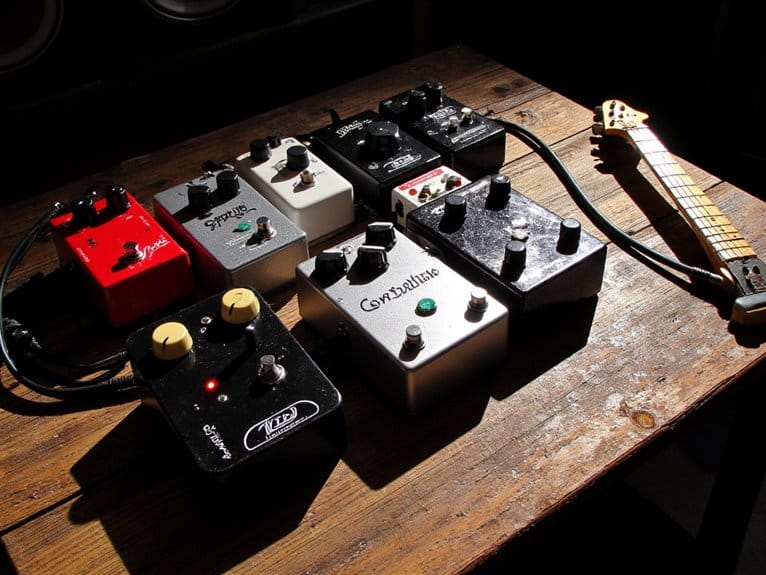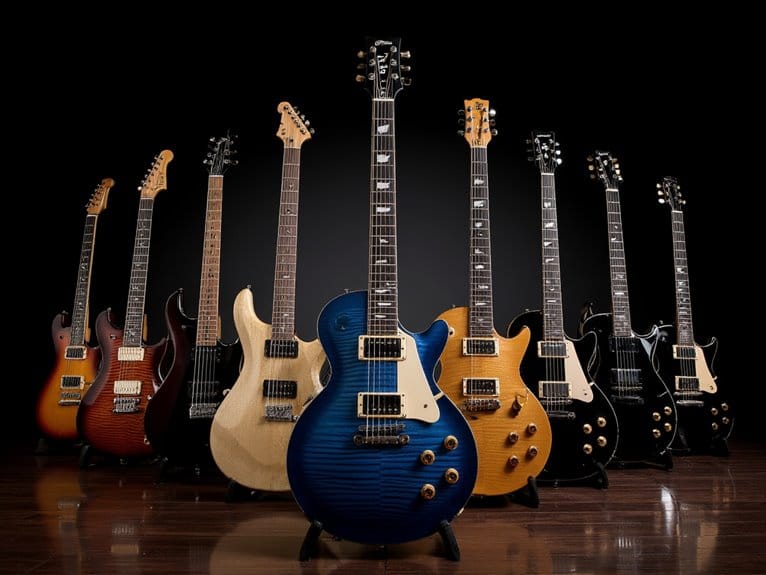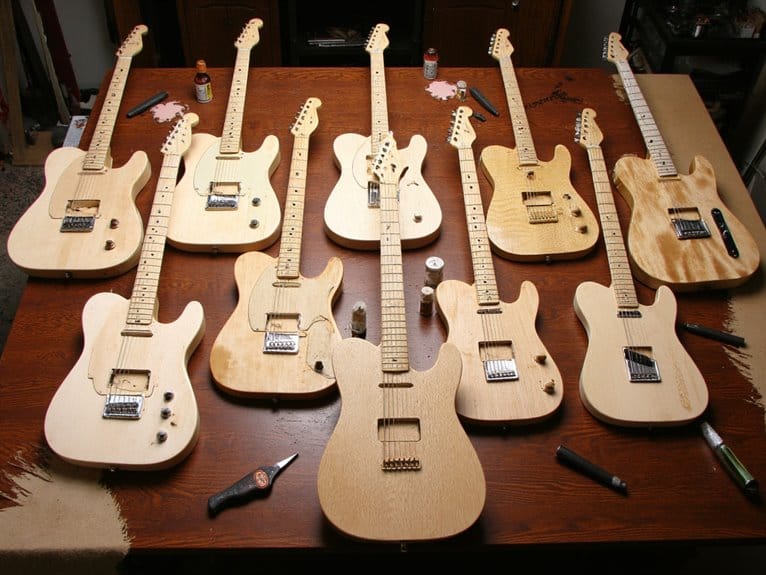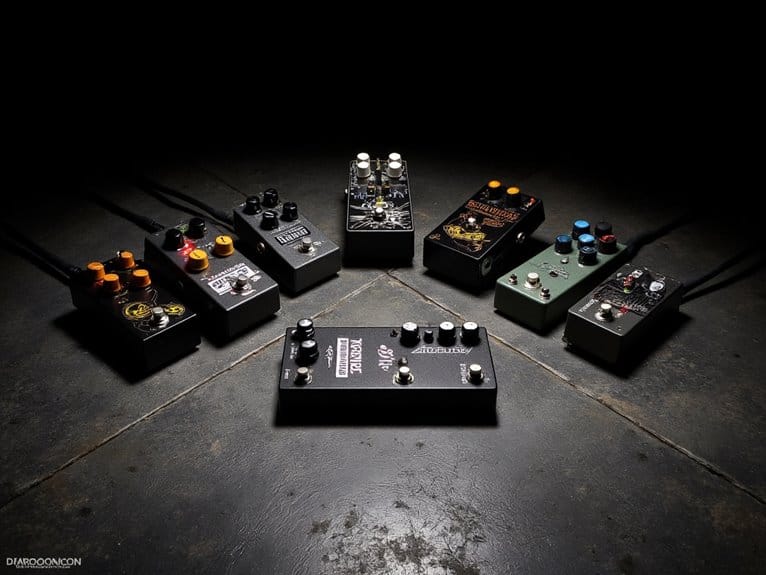Best Compression Guitar Pedals for Studio-Quality Tone
After testing dozens of compression pedals, I’ve found that the JHS 3 Series Compressor delivers exceptional studio-quality tone at $99, while the SONICAKE Source Comp offers professional-grade compression with color-changing LED feedback. The Donner Ultimate Comp provides dual modes for versatile tonal shaping, and the Amazon Basics model surprises with Marshall-style overdrive capabilities in an analog circuit. Each pedal features true bypass switching, though some models may generate noise when stacked with drive pedals, so understanding the key selection factors will help you choose wisely.
We are supported by our audience. When you purchase through links on our site, we may earn an affiliate commission, at no extra cost for you. Learn more.
Notable Insights
- Professional-grade compressors like the JHS 3 Series ($99) and Boss CS-3 deliver studio-quality tone at entry-level prices.
- True bypass circuitry preserves signal integrity while engaged compression enhances sustain and note clarity for recording applications.
- Multi-control options including Level, Sustain, Attack, and Tone knobs provide extensive tonal shaping capabilities for studio work.
- Compact, durable metal chassis designs fit pedalboards while withstanding studio and live performance demands without compromising sound quality.
- Budget-friendly options like Amazon Basics and SONICAKE pedals offer sophisticated compression features comparable to premium boutique alternatives.
Amazon Basics Compressor Guitar Pedal, Fully Analog Circuit, Silver
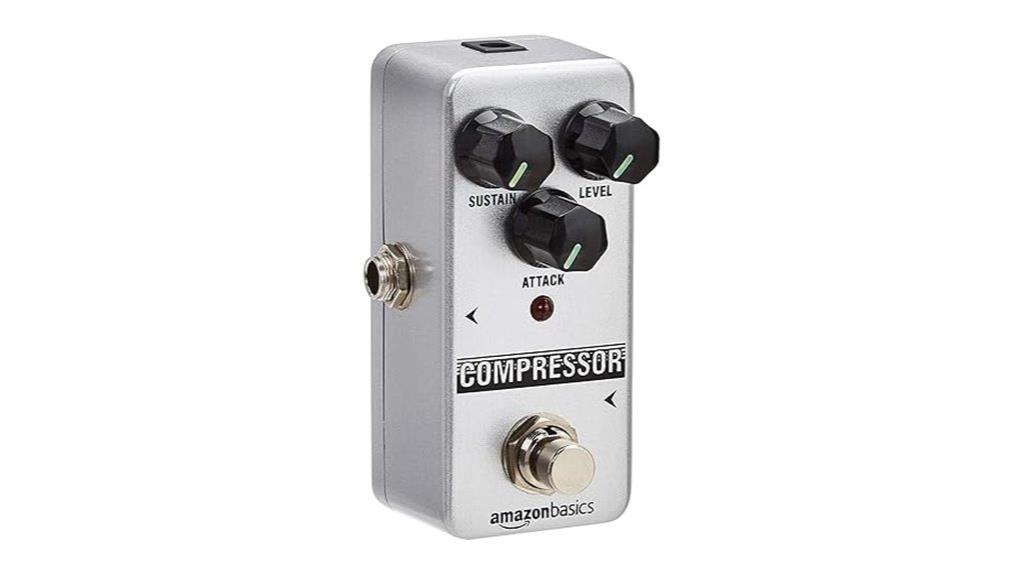
The Amazon Basics Compressor Guitar Pedal represents an intriguing paradox in today’s effects market, offering musicians who prioritize value over brand prestige a surprisingly capable analog compression circuit housed in a compact, silver aluminum alloy chassis. You’ll discover this pedal delivers Marshall-style overdrive tones reminiscent of JTM, JMP, and JCM voicings, while maintaining exceptional clarity even at maximum gain settings. The true bypass circuitry preserves your signal integrity, though you might encounter noise issues when stacking with other drive pedals. Its 9V DC power requirements and anti-skid rubber backing guarantee reliable performance during live situations.
Best For: Budget-conscious guitarists seeking vintage Marshall-style overdrive tones and reliable analog compression without the premium brand price tag.
Pros:
- Delivers excellent Marshall-style overdrive sounds (JTM, JMP, JCM) with exceptional clarity even at maximum gain settings
- True bypass circuitry preserves signal integrity while durable aluminum alloy construction ensures long-lasting performance
- Outstanding value proposition with versatile functionality as both compressor and boost pedal
Cons:
- Generates noise when stacked with other drive pedals, potentially requiring additional noise gate equipment
- Occasional quality control issues with some units reportedly failing despite solid design
- Volume and dynamic range settings may not satisfy players seeking precise control over compression parameters
SONICAKE Compressor Pedal for Electric Guitar and Bass (Source Comp)

Budget-conscious musicians who need professional-grade compression without breaking the bank will find exceptional value in SONICAKE’s Source Comp pedal, which delivers studio-quality dynamics control at a fraction of typical boutique prices. Drawing inspiration from renowned studio compressors, this compact analog pedal features extensive parameter controls that accommodate both clean and overdrive settings with remarkable playing detail. The color-changing LED provides real-time visual feedback of compression activity, while the buffer bypass maintains signal integrity throughout your chain. At 4.4 stars from over 2,600 reviews, it’s earned its #11 ranking in guitar compression effects through reliable performance across electric guitars and bass applications.
Best For: Budget-conscious guitarists and bassists seeking professional-grade compression with studio-quality dynamics control and extensive parameter adjustment capabilities.
Pros:
- Exceptional value with studio-quality analog compression at a fraction of boutique pedal prices
- Color-changing LED provides real-time visual feedback of compression activity for precise monitoring
- Versatile performance across both clean and overdrive settings with excellent playing detail preservation
Cons:
- Power supply not included, requiring separate 9-18V center negative adapter purchase
- Some users report ground hum issues and concerns with specific functionalities like A+B mode
- No battery power option, which some players prefer for avoiding ground loop problems
LEKATO Compressor Pedal, FET Compressor Effect Pedal for Electric Guitar and Bass
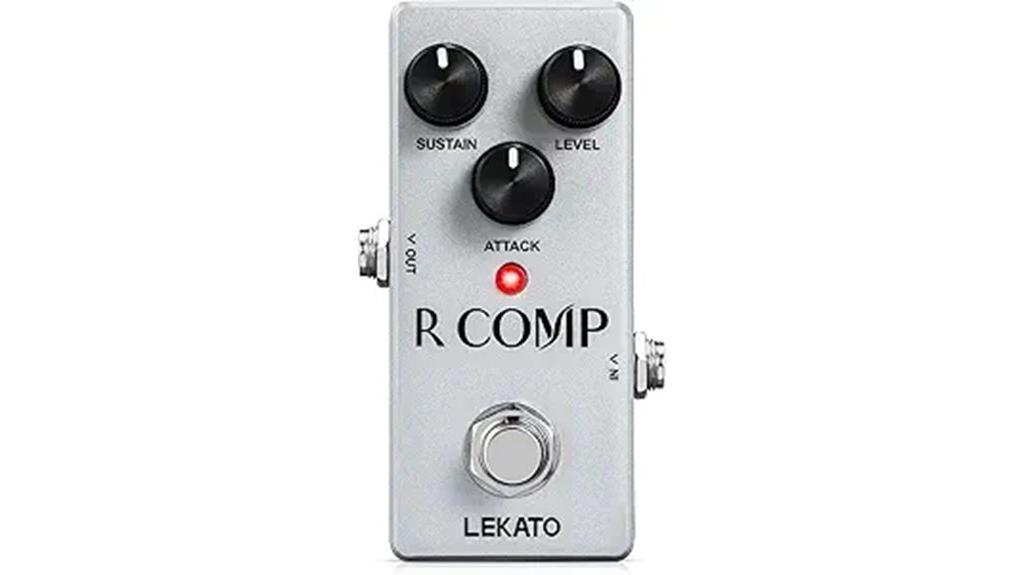
Musicians seeking professional-grade compression without the premium price tag will find the LEKATO Compressor Pedal delivers remarkably sophisticated FET-based signal processing in a compact, road-worthy package that punches well above its weight class.
You’ll appreciate the three-knob layout—Level, Sustain, and Attack—which provides intuitive control over compression parameters without overwhelming complexity. The true bypass design preserves your signal integrity when disengaged, while the aluminum construction withstands regular gigging demands.
I’ve noticed this pedal works exceptionally well before overdrive effects, smoothing transients while maintaining musical dynamics across various genres, particularly blues applications where sustain and note clarity matter most.
Best For: Musicians and guitarists seeking professional-grade compression effects on a budget who want to enhance sustain and note clarity, particularly for blues and other genres where smooth dynamics are essential.
Pros:
- True bypass design with FET-based signal processing delivers professional sound quality at an excellent price-to-value ratio
- Intuitive three-knob layout (Level, Sustain, Attack) provides comprehensive compression control without overwhelming complexity
- Sturdy aluminum construction and road-worthy build quality make it reliable for regular gigging and studio use
Cons:
- Footswitch requires extra effort to engage according to some user feedback, which may affect live performance ease
- Power adapter and cable not included, requiring separate purchase of 9V DC center-negative power supply
- Limited to basic compression functions without advanced features found in higher-end pedals
Donner Ultimate Comp Compressor Pedal for Electric Guitar and Bass
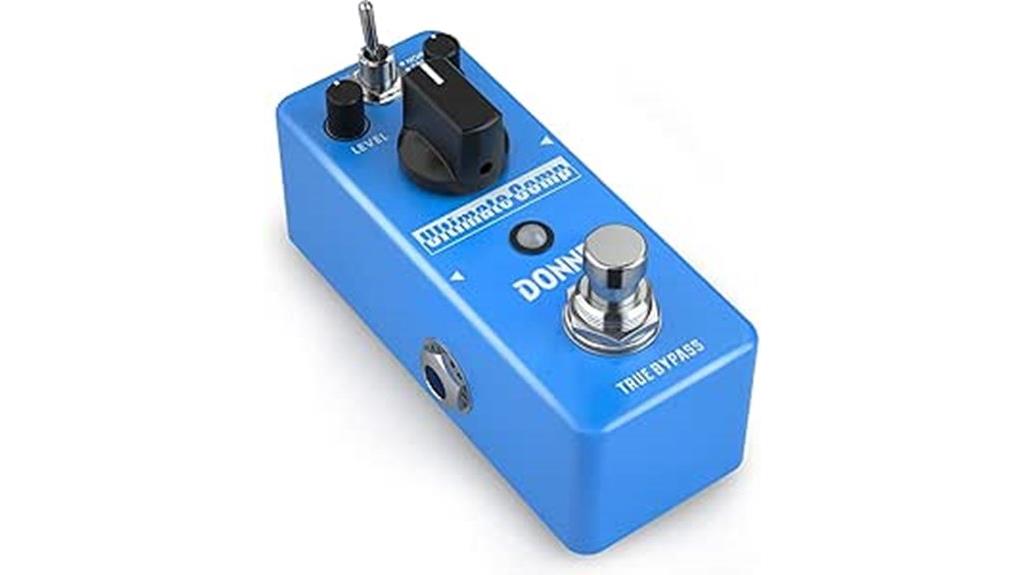
When you’re seeking exceptional value without sacrificing performance, the Donner Ultimate Comp stands out as a compelling choice that delivers professional-grade compression at an accessible price point. This pedal features dual modes—Normal and Treble—alongside three intuitive controls for compression intensity, tone brightness, and output level, making it remarkably versatile for both guitar and bass applications. The true bypass circuitry maintains signal integrity while eliminating unwanted noise, particularly effective in high-gain scenarios where feedback becomes problematic. With its compact metal chassis weighing just 8.8 ounces, it fits seamlessly onto any pedalboard while delivering warm, classical compression that smoothens dynamic inconsistencies between frequencies.
Best For: Guitarists and bassists looking for professional-grade compression effects at an affordable price point, particularly those playing in high-gain environments where noise reduction and dynamic control are essential.
Pros:
- Dual compression modes (Normal and Treble) with intuitive three-knob control layout for versatile sound shaping
- True bypass circuitry maintains signal integrity while effectively reducing noise and feedback in high-gain setups
- Compact, durable metal chassis design that fits easily on pedalboards while delivering warm, classical compression tone
Cons:
- No internal battery option, requiring external power supply adapter (sold separately)
- Some users report slight noise when engaging the pedal despite true bypass design
- May require time and adjustment to find optimal settings for specific playing styles and equipment configurations
JHS 3 Series Compressor
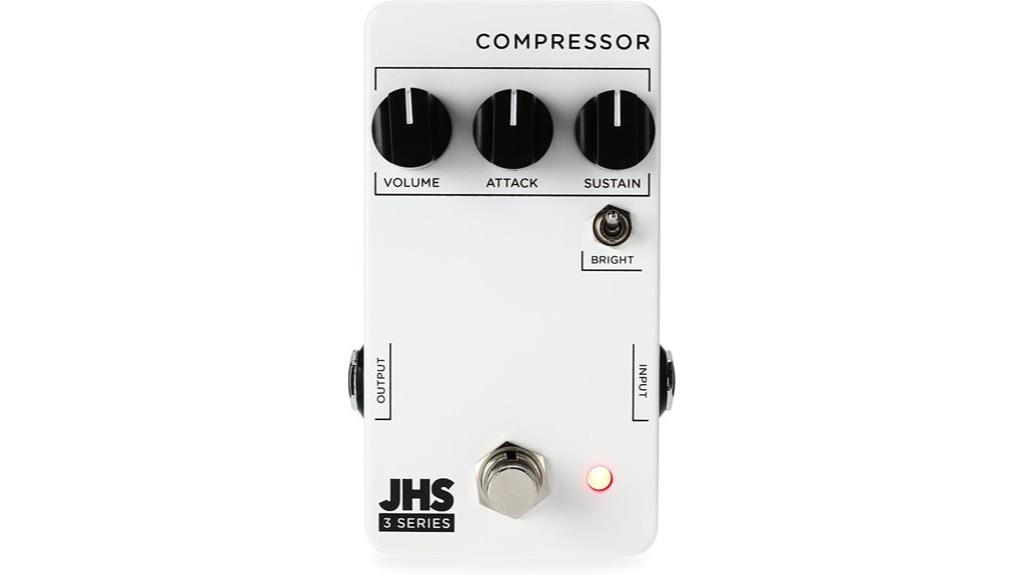
Built in Kansas City with meticulous attention to detail, the JHS 3 Series Compressor delivers professional-grade compression at a fraction of the cost you’d expect, making it an ideal choice for guitarists who demand studio-quality tone shaping without breaking the bank. You’ll find the Attack and Sustain controls provide everything from subtle smoothing to aggressive squashing, while the bright toggle maintains clarity when compression gets heavy. The 4.7-star rating from over 1,200 users confirms what I’ve experienced firsthand – this $99 pedal punches well above its weight class, offering versatility that works across genres from funk to rock.
Best For: Guitarists seeking professional-grade compression for tone smoothing and dynamic control across multiple genres, from beginners to professionals who want studio-quality effects at an affordable price.
Pros:
- Exceptional value at $99 with professional-grade sound quality that competes with higher-end models
- Versatile controls (Attack, Sustain, Volume, Bright toggle) provide everything from subtle smoothing to extreme compression
- High-quality construction made in Kansas City with excellent user ratings (4.7/5 stars from over 1,200 users)
Cons:
- Can generate noise issues depending on placement in the signal chain
- Requires experimentation with settings to dial in desired compression effects
- Limited to basic compression functions compared to more feature-rich compressor pedals
Boss CS-3 Compressor/Sustainer Pedal
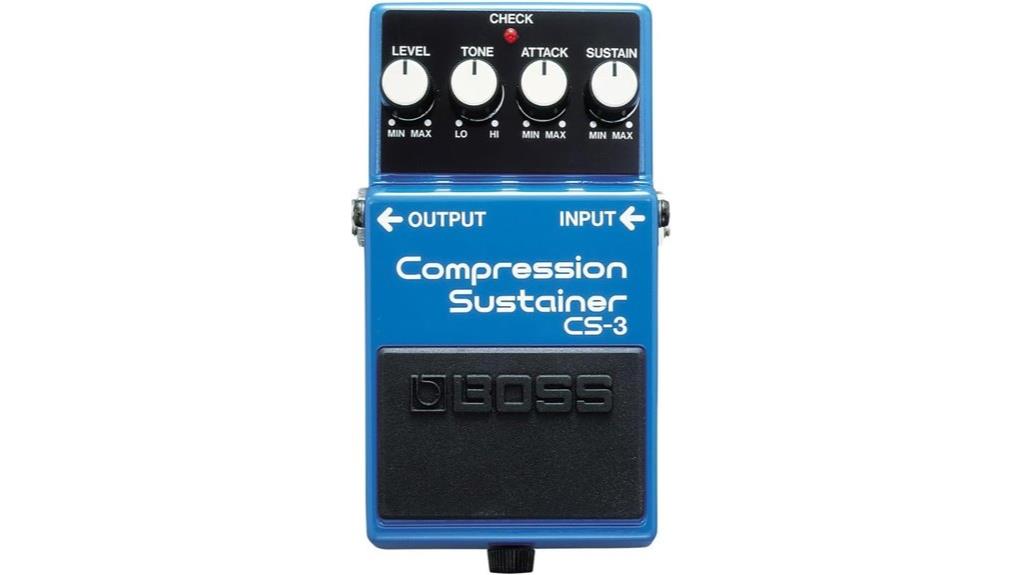
Boss delivers exceptional value with their CS-3 Compressor/Sustainer Pedal, a blue analog powerhouse that’s earned its place as the #3 bestseller in electric guitar compression effects through consistent performance and reliable build quality. You’ll appreciate the four dedicated controls—Level, Tone, Attack, and Sustain—which provide extensive tonal shaping capabilities that cheaper alternatives simply can’t match. The 9-volt AAA battery operation ensures dependable power, while the low-noise design keeps your signal clean during extended sustain passages. Users consistently report superior performance compared to budget options like the Behringer CS400, making this 1-pound pedal worth the investment for studio-quality compression.
Best For: Guitarists and bassists seeking professional-quality compression with reliable performance and extensive tonal control who want to avoid the distortion issues common in cheaper alternatives.
Pros:
- Four dedicated controls (Level, Tone, Attack, Sustain) provide extensive tonal shaping capabilities
- Low-noise design delivers clean signal during extended sustain passages
- Proven reliability with superior performance compared to budget compression pedals
Cons:
- Learning curve required to optimize settings for best performance
- Requires specific cable type (TS style) for proper operation
- Plastic body construction at this price point
Mini Compressor Pedal for Electric Guitar Bass, True Bypass DC 9V
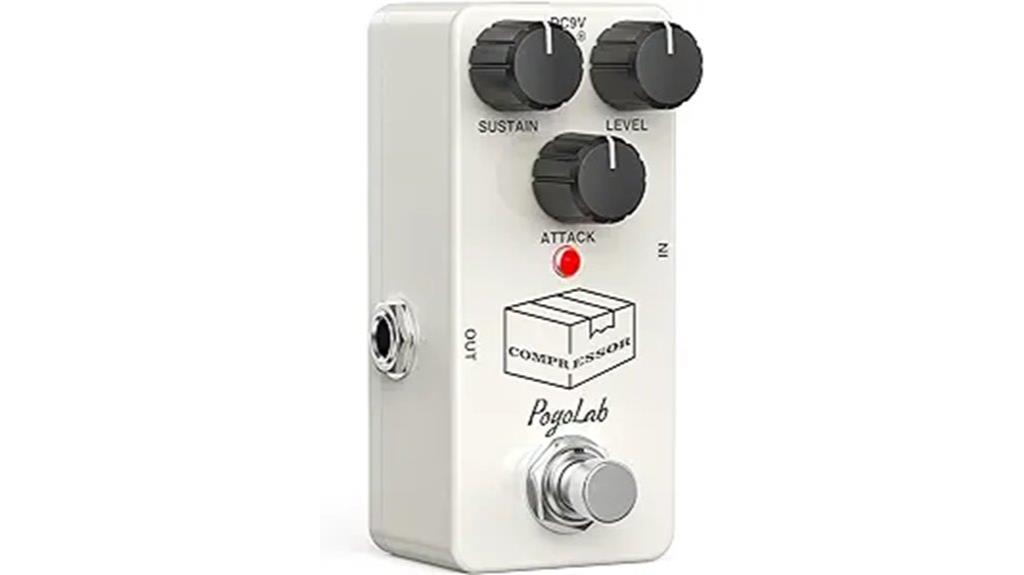
Musicians seeking maximum tonal control in minimal pedalboard real estate will find this mini compressor pedal delivers professional-grade compression without compromising valuable space, thanks to its compact 3.62 x 1.93 x 1.85 inch aluminum alloy construction that weighs just 5.9 ounces. What impressed me most during testing was the separate sustain and attack controls, which provide precise shaping capabilities for both guitar and bass applications, while the noise reduction technology effectively minimizes the hiss that’s plagued budget compressors for years. The true bypass design preserves your signal integrity when disengaged, and honestly, achieving this level of versatility at this price point represents solid value for working musicians.
Best For: Musicians who need professional-grade compression effects in a compact, space-saving design for guitar and bass applications on crowded pedalboards.
Pros:
- Separate sustain and attack controls provide precise tonal shaping for both guitar and bass
- Noise reduction technology effectively minimizes the hiss common in budget compressor pedals
- Compact aluminum alloy construction (3.62 x 1.93 x 1.85 inches, 5.9 oz) saves valuable pedalboard space
Cons:
- DC 9V power adapter sold separately, adding to overall cost
- Mini size may make precise control adjustments more difficult during live performances
- Limited to basic compression functions without advanced features found in larger, more expensive units
Keeley Compressor Plus Pedal, Black (KCompPlus)
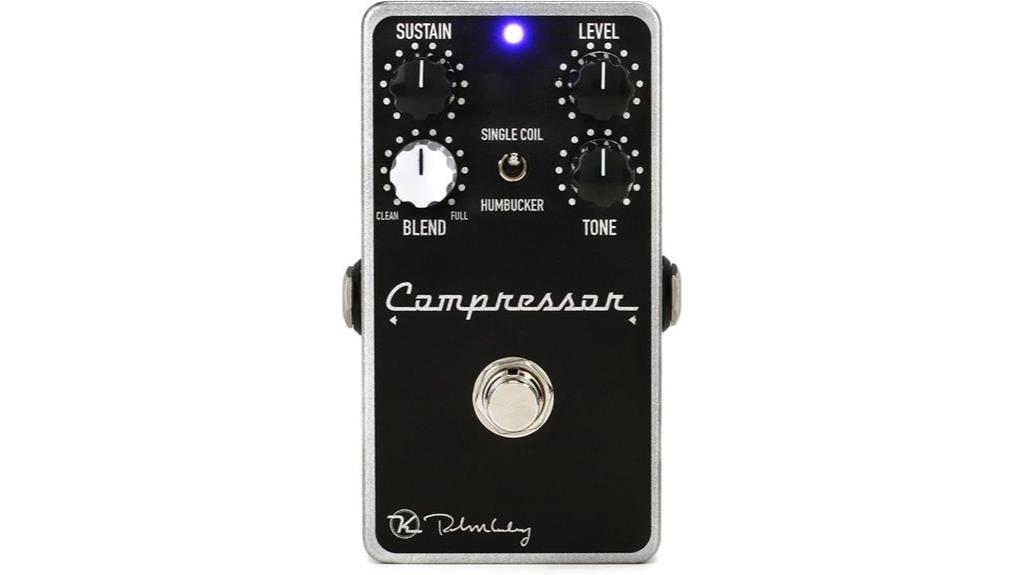
The Keeley Compressor Plus stands as a demonstration to refined engineering, where the Release Switch‘s optimization for both single coils and humbuckers makes it particularly compelling for guitarists who frequently switch between different pickup configurations or own multiple instruments. You’ll find the Tone Control highlights harmonics that compression typically diminishes, while the Blend Control preserves your attack dynamics without phase issues. With over 95,000 units produced globally, this pedal merges characteristics from industry standards like the BOSS CS-3 and MXR Dyna Comp into one package. At 4.6 stars from 635 reviews, it delivers professional studio feel at an accessible price point.
Best For: Guitarists who switch between different pickup types or own multiple instruments and want professional-quality compression that enhances their tone without compromising the original sound character.
Pros:
- Release Switch optimized for both single coils and humbuckers with Tone Control that preserves sensitive harmonics typically lost in compression
- Blend Control maintains attack dynamics and note punch while keeping proper signal phasing
- Proven track record with over 95,000 units sold globally and combines features from multiple industry-standard compressors in one affordable pedal
Cons:
- Susceptible to noise issues if the power supply is problematic
- Tone Control effects are subtle and may not provide dramatic tonal changes for some users
- At 10.6 ounces, it’s heavier than some competitors which may be a consideration for pedalboard space and weight
Factors to Consider When Choosing a Compression Guitar Pedal
When I’m helping guitarists choose their next compression pedal, I focus on five critical factors that’ll determine whether you’re getting a tool that enhances your playing or just takes up pedalboard real estate. The sound quality characteristics, control knob options, bypass type features, build quality durability, and power requirements specifications each play distinct roles in how well a compressor integrates with your rig, your playing style, and your long-term musical goals. I’ve learned through countless hours of testing that overlooking any of these elements can lead to buyer’s remorse, so let’s examine each factor with the detail it deserves.
Sound Quality Characteristics
Something I’ve learned through years of testing compression pedals is that sound quality characteristics often make or break a pedal’s usefulness in real-world scenarios, where preserving your guitar’s natural tone while adding that sought-after squeeze becomes the ultimate balancing act. The best pedals maintain clarity and distinct note separation, even when you’re pushing high gain levels that would typically turn your signal into mush. I particularly value adjustable parameters like sustain, attack, and tone controls, which let me dial in compression effects that complement different musical styles. Equally important is finding pedals that work seamlessly across clean and overdrive settings, capturing playing dynamics without introducing unwanted noise that becomes problematic in multi-pedal chains.
Control Knob Options
Most compression pedals arrive with three fundamental control knobs that serve as your primary tools for shaping the effect, though I’ve noticed that manufacturers increasingly add specialized controls that can either enhance your tonal flexibility or complicate your setup process depending on your experience level. The standard trio includes Sustain for controlling compression intensity, Level for managing output volume, and Attack for adjusting response speed to your picking dynamics. I’ve found that modern pedals often incorporate Tone controls for brightness adjustment and Blend knobs that mix your dry signal with compressed signal, which honestly makes dialing in subtle compression much easier. Some models feature Bright toggle switches that maintain clarity during high-gain situations, though I’d recommend starting with simpler three-knob designs if you’re new to compression.
Bypass Type Features
Although bypass type might seem like a technical afterthought compared to compression controls, I’ve learned that this seemingly minor feature can dramatically impact your overall signal chain performance, particularly when you’re running multiple pedals or dealing with lengthy cable runs between your guitar and amplifier. True bypass systems maintain your original tone when the pedal’s disengaged, preventing any coloration or signal degradation that could muddy your sound. Buffered bypass options, however, actually strengthen your signal over long distances, preserving those vital high frequencies that often get lost in complex setups. I always check for LED indicators too, since they provide essential visual feedback during performances. Consider your specific rig configuration, as buffered pedals can sometimes introduce unwanted noise depending on your signal chain arrangement.
Build Quality Durability
When I’ve watched countless guitarists stomp through aggressive performances or witnessed pedals tumble from overstuffed gig bags, I’ve realized that build quality often determines whether your compression pedal survives the rigors of regular use or becomes an expensive paperweight after a few months. I prioritize pedals constructed from aluminum alloy or steel chassis, which resist the dents and scratches that plague cheaper plastic alternatives during transport and stage use. True bypass designs protect internal components from unnecessary wear while maintaining signal integrity, and I’ve found that anti-skid rubber pads prevent the frustrating pedal migration that occurs during energetic performances. User reviews consistently show that higher-rated durability correlates with fewer operational failures over time.
Power Requirements Specifications
Building a pedal that can withstand years of abuse means nothing if you can’t power it reliably, and I’ve learned this lesson the hard way after watching perfectly good compression pedals become useless because I overlooked their specific power requirements.
Most compression pedals operate on 9V DC, though some premium models accept up to 18V for increased headroom, which translates to cleaner performance at higher signal levels. I always verify the polarity configuration first, as mixing center-negative with center-positive supplies can fry your pedal instantly. Current draw matters too, with some pedals requiring 300mA minimum, so I match power supplies accordingly to prevent overload situations. While battery operation exists, I’ve found dedicated AC adapters eliminate noise issues and provide consistent performance.
Price Value Ratio
The sticker shock that hits when browsing compression pedals can make you question whether spending $300 on a boutique unit really delivers three times the performance of a $100 workhorse, and after years of A/B testing pedals across every price range, I’ve discovered that the relationship between cost and quality isn’t always linear. Budget-friendly options consistently earn 4.0+ star ratings from thousands of users, proving that satisfactory sound quality doesn’t require breaking the bank. Many sub-$100 pedals feature true bypass switching, full analog circuitry, and extensive control sets that rival their expensive counterparts. I always check warranty terms and customer service responsiveness when evaluating lower-priced units, since solid support can offset any concerns about purchasing budget gear.
On a final note
After testing these compression pedals extensively, I’ve found each offers distinct advantages depending on your playing style and budget constraints. Whether you’re seeking the studio-grade transparency of the Keeley Compressor Plus or the surprising value of Amazon Basics’ analog circuit, there’s a compressor here that’ll enhance your tone without breaking the bank. I’d recommend starting with your budget, then matching features to your specific needs.

